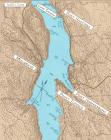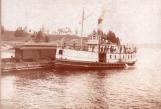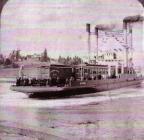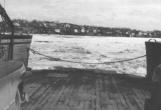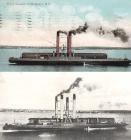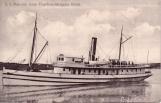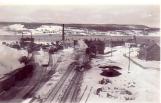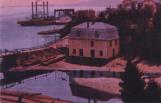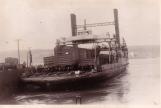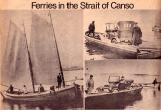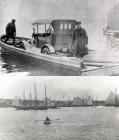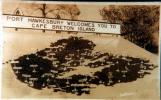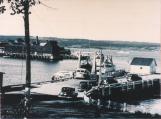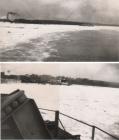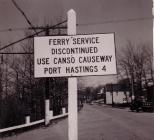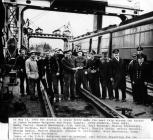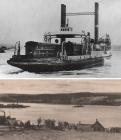

Gut of Canso Museum and Archives
Port Hastings, Nova Scotia
2
EARLY FERRY SERVICE IN THE GUT OF CANSO - The Strait of Canso, separating Cape Breton Island from the mainland of Nova Scotia was always an obstacle for travellers and mail.Hugh MacMillan of Port Hastings was one of the prominent early ferry operators who operated as early as 1819 between Auld's Cove on the western side of the Strait of Canso and Port Hastings on the Cape Breton side. In 1829, he sent a letter of petition to the Provincial Legislature asking for his yearly operating grant to be increased, for the reason that "he has for these ten years kept a regular ferry operating in the Gut of Canso" but that he felt the need to expand was necessary. MacMillan wrote that "[in] these few years past, horses and other cattle to be ferried require boats suitable for such purposes" and after having purchased such boats, and keeping them in repair, the "yearly sum of six pounds... (is) inadequate to answer the expenses."
4
FERRYMEN IN THE STRAIT OF CANSO - By 1847, there were three ferry services crossing the Strait. They ran between Auld's Cove and Plaister Cove, Mulgrave and Port Hawkesbury, and Steep Creek and McPherson's Ferry. Each of the services had a small barge that would carry a horse and a wagon. That same year, Richard Carter of Steep Creek, Guysborough County, and David MacPherson of McPherson's Ferry, both received a grant of 10 pounds to operate their ferries.A 10 pound grant was awarded Isaiah Embree in 1857 to operate a ferry between Port Mulgrave and Ship Harbour (Port Hawkesbury).
5
SS EXPERIMENT & SS NORWEIGAN - The first steam ferry was the S.S. Experiment in 1860. It was Albert McBean who received a provincial grant of 750 pounds to start this service. It operated twice daily between Ship Harbour (Port Hawkesbury), Port Mulgrave, Plaister Cove (Port Hastings) and Auld's Cove.In 1880, the Cape Breton Railway Co. began operating the SS Norwegian between Wyld's Wharf in Mulgrave and Grant's Wharf in Port Hawkesbury. Five years later, the company built a winter dock at Point Tupper and picked up the contract for delivery of mail.
In the years leading up to 20th century, private ferry service continued to thrive, with the services being fine tuned to serve the area.
7
THE EVOLUTION OF TRAIN FERRIES - The era of the sailing ships was declining as the railway development progressed coming as far as Mulgrave on mainland Nova Scotia in 1880. Ten years later, the railway would be completed on Cape Breton Island between Point Tupper and Sydney. By 1893, the rail connection between mainland Nova Scotia and Cape Breton Island was made by the S.S. Mulgrave, a steam ship powerful enough to move a nine car passenger train on a scow.Mulgrave resident and rail ferry employee Hiram Crittenden spoke of the Mulgrave in a 1979 interview with Cape Breton's Magazine."She looked just like a passenger boat. She used to tow a scow. The train cars would go aboard tracks on the scow. I think she carried 3 passenger cars and probably 3 or 4 small freight cars. The load would only be small. Then the Mulgrave would hook onto the side of that scow, and she'd weather that thing over through the ice nearly all the winter".
9
FIRST SELF PROPELLED TRAIN FERRY - The Scotia, the first self propelled train ferry to operate in the Strait of Canso, is seen here in 1902 leaving Port Mulgrave. Built in England, it was a coal-fired vessel.Hiram Crittenden told Cape Breton's Magazine about the different types of coal used to drive the Scotia."Those boats, when they came here, had Welsh coal aboard of her. Well, you couldn't get anything better for steaming. It was lovely coal. Then they got using the Cape Breton coal. The Old Sydney coal was the best coal that ever Canada put out. Old Sydney coal, that was the name of the mine. And then they got around to the Bras d'Or coal and the Inverness coal. Well, Inverness coal was lovely steaming coal because I know it, I've used lots of it and know what it is. But it was bad for ashes. But no trouble to steam with the Inverness coal".
11
Earle Embree, son of ferryman James Embree, explained problems with crossing in winter in an interview with Cape Breton's Magazine.".....There was just a stream of ice in the centre of the Strait going to the southward for four hours, and when the tide would turn, it would run to the north for four hours. .....
Although the train ferries were heavier and able to absorb the impact of the ice and continued to cross in the winter, there were many times when they had problems with the ice".
Hiram Crittenden discussed these problems in an interview with Cape Breton's Magazine.
"One morning, I saw the ice grab the Scotia and take her way down the Strait and she didn't get back till 3 o'clock in the afternoon. That's from early morning. You could never plan on getting across [on schedule]."
13
WORKING ON THE FERRIES - Working in the depths of the coal-powered train ferries, the Scotia and later,Scotia II, Mulgrave's Hiram Crittenden recalled the tough working conditions he and the other men on the crew faced in an interview with Ron Caplan of the Cape Breton's Magazine."The heat down there - oh my God, she was cruel. I've come home here in the morning, about 6 o'clock, and wearing something heavy on your feet you know, and my boots would be white with the salt out of my body. I used to tell the boys, people would wonder if we had our right senses, to work down there. And you couldn't see anything. Someone would come down now and then, tell us where we were. Say, for instance, We'll just get by this ice pan and we'll be all right."
15
WE TRAVELLED BY PASSENGER BOATS -Many made regular scheduled stops. In 1894, it was the S.S. Eldon that did the loop from Port Hawkesbury to Port Hastings to Mulgrave to Point Tupper. The Eldon left Point Tupper after the express train from Sydney had arrived. Other boats ran from Port Hawkesbury to Arichat and Sydney. The SS Cann made the Guysborough to Mulgrave trip.
There were cruise ships in the Strait of Canso during the summer and many travelled on the Boston Boats to visit or work in the New England States areas.
17
Many ships traveled back and forth from New England. The arrival of such vessels in Port Hawkesbury is discussed in "Port Hawkesbury, Nova Scotia - A Glimpse of the Past.""Everyone looked forward to the arrival of the ships from Boston - 'The Boston States', as it was often called. On the day of arrival scores of people went down to the docks to catch a glimpse of the latest fashions and to meet long lost relatives. Most of these relatives had left Cape Breton in their early teens to work as maids and carpenters' helpers, and returned - often sporting fancy clothes and a Boston accent - still homesick many years later."
19
SCOTIA ll TRAIN FERRY - Following the outbreak of World War I, the need for materials from the industries of eastern Cape Breton, especially the coal and steel, put a strain on the ferry system at the Strait of Canso. A new ferry, the Scotia II, was put into service in 1915. At over 300 feet long and a capacity of 18 45-foot rail cars - 6 each on 3 tracks - the Scotia II - operating with the first Scotia - helped ease the bottleneck of freight crossing the Strait of Canso. Like the Scotia, the Scotia II was a coal-powered ship.During WW II, there was a fear that German submarines might try to sink the train ferries to prevent the coal and steel supply reaching its destination.
21
POINT TUPPER RAIL YARD - Point Tupper began to grow and more men were needed to keep tracks clear and the trains going. Locomotives or engines were not transported across the Strait of Canso on the ferries. When a train arrived in Mulgrave or Point Tupper, whether passenger or freight, the locomotive would detach and the cars would enter a queue to cross the Strait. The process of loading was explained in Cape Breton's Magazine by Hiram Crittenden."Where the boat came to the wharf, there was an apron that would go up or down about 5 or 6 feet, to correspond with the tide and the boat. The apron had rails on it, and had to come right down aboard the boat - they'd couple it up with what they called latches. That would link the boat to the wharf, and the three sets of tracks on the Scotia would be linked up to the tracks in the railway yard... They'd make the trains right there, push them on and haul them off the boats with the yard engine. It took a lot of man power to keep these rails clear all winter".
23
WORKING CONDITIONS ON THE SCOTIA - Sitting blind in the bowels of the ship, the work crews would encounter problems with little idea about what was happening on deck, or around the ship. Hiram Crittenden explained in an interview in the Cape Breton's Magazine."We'd get so far to the docks, we'd be almost ready to couple her up - and something would happen down below - shut everything off. Now that would be ice clogging the condenser. Normally the salt water came up through the bottom of the boat and into the condenser, and you, and you could see the stream of water flowing out again, out the side of the boat. And when the ice would clog the water it would kill the dynamo, lights went out and we'd have to shut our engines down".
25
FERRY RAILWAY TRAFFIC - According to a Department of Mines and Technical Surveys done in 1953, the volume of railway traffic transported by ferry boats had been 40,000 in 1920 and was up to 115,000 by 1946.The heavier traffic of commodities was always westward rather than eastward across the Strait to Mulgrave and the rest of Canada - coal and later steel from Industrial Cape Breton being the main products. The largest tonnage going east to Cape Breton was composed of general freight and food.
27
FERRYMEN EMBREE and WALKER - Captain James Embree of Port Hawkesbury is credited with being the first operator of a vehicle carrying ferry in the Strait of Canso in 1913. His father ran a private ferry before him. James' ferry was a flat bottomed scow pulled by a kind of sail boat or it was rowed.In 1922, Captian P.J. Walker was granted the monopoly on ferrying automobiles across the Strait of Canso. His ferry was built as a landing barge for WW I but he refurbished it to become the Edith C. Walker in 1925. In her last year of operation, 1925, the Edith C. Walker ferried a total of 2,904 automobiles.
29
The first ferries in the Strait of Canso were not much more than a scow pulled by a boat. In the top picture, c. 1910, an early ferry operator transports a car across the Strait.The lower picture shows a local resident in a rowboat among large vessels in Port Hawkesbury's harbour.
When conditions in the Strait were right, anybody with a small craft could make the crossing but with the strong currents, it was a challenge at the best of times and almost impossible in winter.
31
GOVERNMENT OPERATED AUTOMOBILE FERRIES BEGIN OPERATIONS - On July 1,1926, car/passenger ferries came under the control of the Nova Scotia Department of Highways. The first government car ferry was the Pont de Canseau, which held ten automobiles. Later came the [Breton] which operated in 1927-28.33
The Sir Charles Tupper, brought into service in the Strait of Canso in 1928, was the largest of the government fleet's first ferries. With a capacity of 18 vehicles, the ferry helped meet the increase in traffic across the Strait. This photo (c. 1940) shows the Tupper at the government wharf in Port Hawkesbury.35
Car ferry docks in Port Hawkesbury on the top and Mulgrave on the bottom.1947
Strait of Canso, Nova Scotia, Canada

36
1930's PONT DE CANSEAU and SIR CHARLES TUPPER AT WHARF - In Port Hawkesbury, the car ferries unloaded at a wharf just south of the current government wharf. From this location, cars leaving the ferry were just yards from Granville St., Port Hawkesbury's main street at the time.The Mulgrave auto ferry dock was north of where the current Mulgrave Superport facility is located. This picture, c. 1950, shows the John Cabot having just departed Mulgrave for Port Hawkesbury. (NS Public Archives Photo)
The sign advertising local handcrafts at the Shanty by the Sea was located in the home of Mrs. Lillian Williams, Mulgrave. She celebrated her 106th birthday on June 16, 2004 still passonate about her home town of Mulgrave.
38
MULGRAVE AUTOMOBILE FERRY DOCK - When automobile traffic became common, it would arrive and leave from this dock in Mulgrave on the mainland side of the Strait of Canso.40
ICE CONDITIONS IN THE STRAIT OF CANSO - Ice conditions on the Strait of Canso forced the shut down of car ferry service in the winter months in the early years. Due to the geography of the region, specifically with the shape of Ship Harbour, ice flow was restricted, blocking the Port Hawkesbury ferry landing. In addition, the hulls of the ferries were not suitable to deal with the hard flow of the ice.41
The John Cabot and George H. Murray auto ferries in the Strait of Canso1948
Strait of Canso, Nova Scotia, Canada
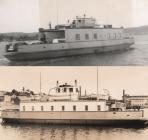
42
The George H. Murray, brought into service in 1940, was the last of the car ferries to serve the Mulgrave to Port Hawkesbury run on the Strait of Canso. The John Cabot had been severely damaged by a fire the first of the month thus forcing an early opening of the Causeway.On May 20th,1955, the George H. Murray made the last official run from Mulgrave to Port Hawkesbury but was used again on August 13th, 1955 , the day of the official opening of the Canso Causeway.
Following the discontinuation of ferry service in the Strait, the George H. Murray and the John Cabot were transferred to service in other parts of Cape Breton.
44
PORT HAWKESBURY AUTO FERRY DOCK - Port Hawkesbury was the gateway to Cape Breton Island at its auto ferry docks until May 20th, 1955 when the Canso Causeway was unofficially opened.The Plant Line Wharf is the big wharf on the right which did a brisk business in the early part of the century. Boston Boats and other passenger liners made scheduled stops.
45
Line up of 154 cars on Granville Street back as far as Embree's Island waiting to get on car ferry.1954
Port Hawkesbury, Inverness County, Nova Scotia, Canada

46
LONG LINE UPS COMMON BY THE 1950'S -Orean West, son of ferry worker J. A. West, wrote in 1984 of the line-ups in memoirs for the Port Hastings Historical Society."During the early years of the 50's, the traffic was so heavy at times that even having both ferries running could not prevent long lines of traffic forming... in Mulgrave and Port Hawkesbury. Labour Day weekend was the worst on record. On Labour Day, 1954, there were at one time 154 vehicles waiting to get across the Strait from Port Hawkesbury. Traffic was lined up from the ferry terminal to Embree's Island".
48
THE JOHN CABOT'S ACCIDENTS - The John Cabot was the last government purchased auto ferry for the Strait of Canso. It encountered two mishaps in the years leading up to the opening of the Canso Causeway - a collision on September 13th,1952 with the CNR steamship Canadian Victor and a fire on May 2nd, 1955.The top picture shows her after the collision and the bottom in the Port Hawkesbury Marine Railway Shipyard in Point Tupper under repairs.
50
The Tourist Information Bureau on the Port Hawkesbury waterfront was built in 1939. It was moved to Port Hastings after the completion of the Canso Causeway in 1955. After add ons and expansions to the building, it has continued serving the travelling public's needs up to the present time in 2005 at the entrance to Cape Breton Island.52
CAR FERRY SERVICE DISCONTINUED - On May 20th,1955, at 12:45 pm., according to Oreon West, the George H. Murray made it's last run from Mulgrave to it's dock in Port Hawkesbury.The John Cabot and the George H. Murray, were transferred to the Ross Ferry service and used elsewhere on Cape Breton Island.
54
THE END OF A WAY OF LIFE - With the completion of the Canso Causeway and Canal, train ferry service was discontinued on the Strait of Canso on May 14,1955. Many of the men were forced to leave the area to find work, often leaving families behind as they weren't able to sell their homes.56
SCOTIA II MOVED - Following the discontinuation of ferry service in the Strait of Canso in 1955, Canadian National Railways put the Scotia II into service in the Northumberland Strait. In the 1960's, CN relocated the ferry once again, as explained in this article, from Nov. 1968: "Canadian National announced Friday that the train ferry Scotia II will be withdrawn from the fleet operating between Cape Tormentine, N.B., and Borden, P.E.I."The ferry, which began its career more than 50 years ago, moving rail cars across the Canso Strait... has been used as a relief ferry on the Northumberland Strait service since 1955, when the Canso Causeway was completed.
J.W.G. MacDougall, CN vice-president for the Atlantic Region, said the ferry will be put in service at Windsor Ont..."
57
Scotia II train ferry leaving the Strait of Canso after the completion of the Canso Causeway in 19551955
Canso Canal, Strait of Canso, Canada
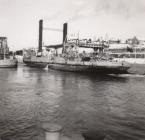
58
AND NOW YOU KNOW THE END OF THE STORY - The Scotia II was eventually converted into a barge and remained in Ontario. In 1987, a story published in the Sarnia (Ontario) Gazette told the story about a displaced Mulgraver finding a floating piece of home in Ontario."The Scotia II, docked along the St. Clair River just south of Ferry Dock Hill, is like a piece of Mulgrave, Nova Scotia, floating in the middle of Sarnia. To [Mel] Purcell, it's his panacea for homesickness.
"You see", explains the retired school teacher and principal, " she's been altered and the old boilers have rusted out and now she's used as a barge and is pushed by tugs, but the Scotia II is the same one I knew in Nova Scotia as a boy". CN officials have confirmed that.
"And", says Purcell, "the Scotia was Mulgrave. The town was so wrapped up in that ferry... She represented our hopes, our fears. When we were kids, we wondered who would grow up to be her captain. When I was a boy, we played hooky from school by climbing aboard and crossing to Cape Breton. Ah, the Scotia".
Once in Sarnia, Purcell was naturally drawn to the water and when he accidentally discovered his beloved 75-year-old ferry "I freaked out about it".

